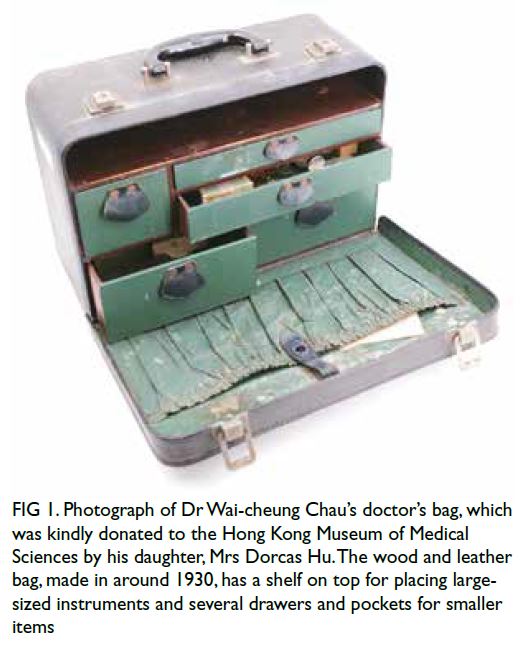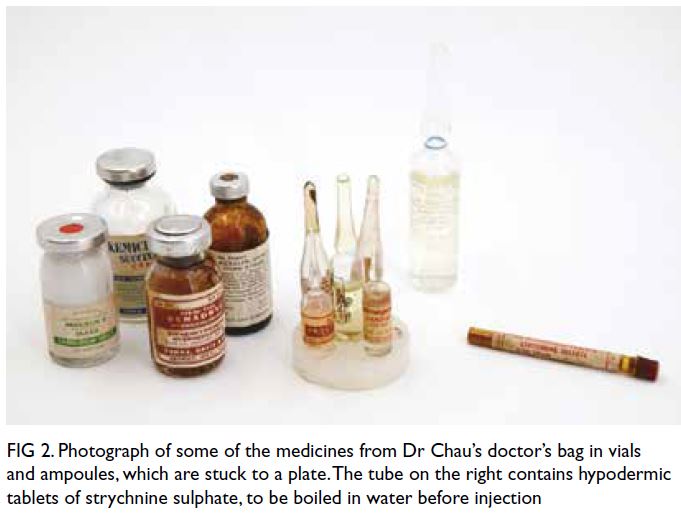© Hong Kong Academy of Medicine. CC BY-NC-ND 4.0
REMINISCENCE: ARTEFACTS FROM THE HONG KONG MUSEUM OF MEDICAL SCIENCES
Doctor’s bag belonging to Dr Wai-cheung Chau
Winnie Tang, MB, BS
Member, Educational and Research Committee, Hong Kong Museum of Medical Sciences Society
These days, to get medical advice from a medical
doctor in Hong Kong, it is usually necessary to go
to a clinic or hospital, but this was not always the
case. In the past, especially in rural and isolated
areas, doctors would visit patients at home; in some
regions outside of Hong Kong, such home visits are
still routine medical practice. To provide correct
diagnosis and treatment during a home visit, a
doctor must carry all the essential equipment and
medications for any circumstance that might arise.
Thus, a doctor’s bag must be strong, reliable, and
easy to carry, with the ability to be opened widely for
easy access to the contents.
Medical practitioners have been carrying such
bags since ancient times, with the first mention of
a doctor’s bag recorded in the Hippocratic Corpus
known as ‘Decorum’, dated to about 350 BCE.1
The type of cases or bags that doctors carried has
changed over time, depending on requirements and
situations, as well as the newest technologies and
fashions. For example, early doctors had wooden or
leather chests mainly for surgical instruments that
were brought on navy ships or taken to war with
the army. Doctors in the eighteenth and nineteenth
centuries often used saddle bags, because the doctors
travelled to the patient’s home on foot or by horse.
By the end of the nineteenth century, the familiar
doctor’s bag based on the Gladstone bag became
widely adopted. These bags are made of stiff leather
over a wooden frame, with a large opening at the top
to allow convenient access.
This doctor’s bag (Fig 1) belonged to Dr Waicheung
Chau (周懷璋醫生). Dr Chau graduated
from the medical school at The University of Hong
Kong in 1916. He worked in public service after
graduation for 2 years at Ho Miu Ling Nethersole
Hospital and Tai Po Dispensary.2 In 1923, he wrote
in the journal of the Hong Kong University Medical
Society, Caduceus, describing his experience of
working in Tai Po Dispensary.3 He had been called to
attend to a patient who had delivered at home 3 days
prior in a hut in Sheung Shui, which was rural Hong
Kong at that time. She had copious loss of blood
because of a retained placenta. Dr Chau was able to
save the patient by removing the placenta piecemeal
while the patient was under chloroform anaesthesia
administered by the midwife who accompanied him. From his account, we can deduce that Dr Chau
brought with him the necessary equipment and
medications to make this possible.

Figure 1. Photograph of Dr Wai-cheung Chau’s doctor’s bag, which was kindly donated to the Hong Kong Museum of Medical Sciences by his daughter, Mrs Dorcas Hu. The wood and leather bag, made in around 1930, has a shelf on top for placing large-sized instruments and several drawers and pockets for smaller items
Dr Chau later worked in private practice, first
in his own private clinic and then at Hong Kong
Sanatorium & Hospital. At that time, house calls
were routine, especially for those too weak to attend
his clinic, and he would have carried this bag, made
around 1930. Unlike the Gladstone-style doctor’s
bags, Dr Chau’s bag is rectangular, similar to a small
suitcase, 35.6 cm (14”) wide, 24.1 cm (9.5”) tall,
and 14.6 cm (5.75”) deep. The bag has a wooden
frame, is lined with thin leather on the outside, has
two metal clasps, a plastic handle on top, and four
metal studs on the bottom. The inside is lined with
waterproof paper and divided into different-sized
compartments, some with drawers with leather flap
handles. The lid is lined with fabric and leather, and
has some pockets for securing small items.
The contents inside a doctor’s bag varied with
the type of practice of the doctor, but were invariably
tools for diagnosis and medication for treatment.1 4
Diagnostic instruments carried in a doctor’s bag
always included a stethoscope, a sphygmomanometer,
a clinical thermometer, a tongue depressor, and some
form of illumination such as a flashlight. Depending
on the patients’ symptoms, the doctor might also
carry other tools, such as a tuning fork, a percussion
hammer, an otoscope, or an ophthalmoscope.
Syringes, needles, cotton wool in spirit, gloves,
dressings, bandages, catheters, and test tubes were
also carried as required. In Dr Chau’s bag, there were
boxes of glass slides for him to prepare smears for
further pathological examination. As technology
improved, some of these items, such as syringes,
needles, gloves, and lancets, were replaced with
disposable versions, and test strips replaced the
bulky laboratory apparatus.
Medication carried in a doctor’s bag was
varied, including drugs for emergency use or for
preventive use. In the nineteenth century, doctors
even carried vaccines to patients’ homes for smallpox
inoculation.4 Although there are often new or more
advanced drugs produced, a doctor’s bag always
carried some core drugs, including antimicrobials,
sedatives, analgesics, anti-asthmatics, anti-allergics,
hormones, cardiac stimulants, and vitamins and
minerals. In Dr Chau’s bag, there was a variety of
medicines. Most drugs carried in a doctor’s bag were
for parenteral administration, and stored in rubber-stoppered
vials, glass ampoules, or hypodermic
tablets in small glass tubes, to be dissolved or boiled
before injection (Fig 2). The parenteral route enabled
the drug to work fast enough for the doctor to observe
the effect and assess whether he could safely leave
the patient after treatment. Further medications, if
required, would be collected from the doctor’s clinic
the next day.

Figure 2. Photograph of some of the medicines from Dr Chau’s doctor’s bag in vials and ampoules, which are stuck to a plate. The tube on the right contains hypodermic tablets of strychnine sulphate, to be boiled in water before injection
Paperwork for home visits was usually simple,
and doctor’s bags usually had only small notepads
for writing prescriptions or clinical records. In Dr
Chau’s bag, there were name cards and envelopes in
the pockets.
As the population of Hong Kong ages, and the
number of homebound individuals increases, there
may be a change in demand for home visits. In the
past 3 years, many medical facilities and services were unavailable because of measure to mitigate the
spread of COVID-19. Thus, many patients had to, or
chose to, isolate themselves at home. Doctors were
called to see patients at care homes for the elderly
or at their private residences, especially at the peak
of the pandemic in Hong Kong in the first half of
2022. Many of these found themselves more at ease
with healthcare service delivered to their residence.
Although home visits by doctors are unlikely to
return to the mainstream as they once were, there
may be increased demand for home visits in future.
If home visits do regain popularity, it is
likely that the doctor’s bag will also enjoy a
resurgence. However, the form will have to evolve
to accommodate modern technology and adapt
to different settings of the patient’s residence,
similar to the bags carried by modern paramedics.
Traditional Gladstone-style doctor’s bags are now
more of a fashion item, and designers have taken
elements from the original bags, modernising and
making stylish briefcases, travel bags, purses, or
handbags. The few remaining original doctor’s bags
have become collectable antique items or museum
exhibit, with some still retaining aromas from the
medicines they once carried.
References
1. Dammery D. A historical account of the doctor’s bag. Aust Fam Physician 2016;45:636-8.
2. Ho FC. Some unusual and some outstanding personalities. In: Ho FC, editor. Western Medicine for Chinese: How
the Hong Kong College of Medicine Achieved a Breakthrough. HKU Press; 2017: 161-3. Crossref
3. Chau WC. Two cases of difficult labour. Caduceus 1923;2:44-5.
4. Low JA. The doctor’s bag in 1911. CMAJ 2012;184:E100-2. Crossref

